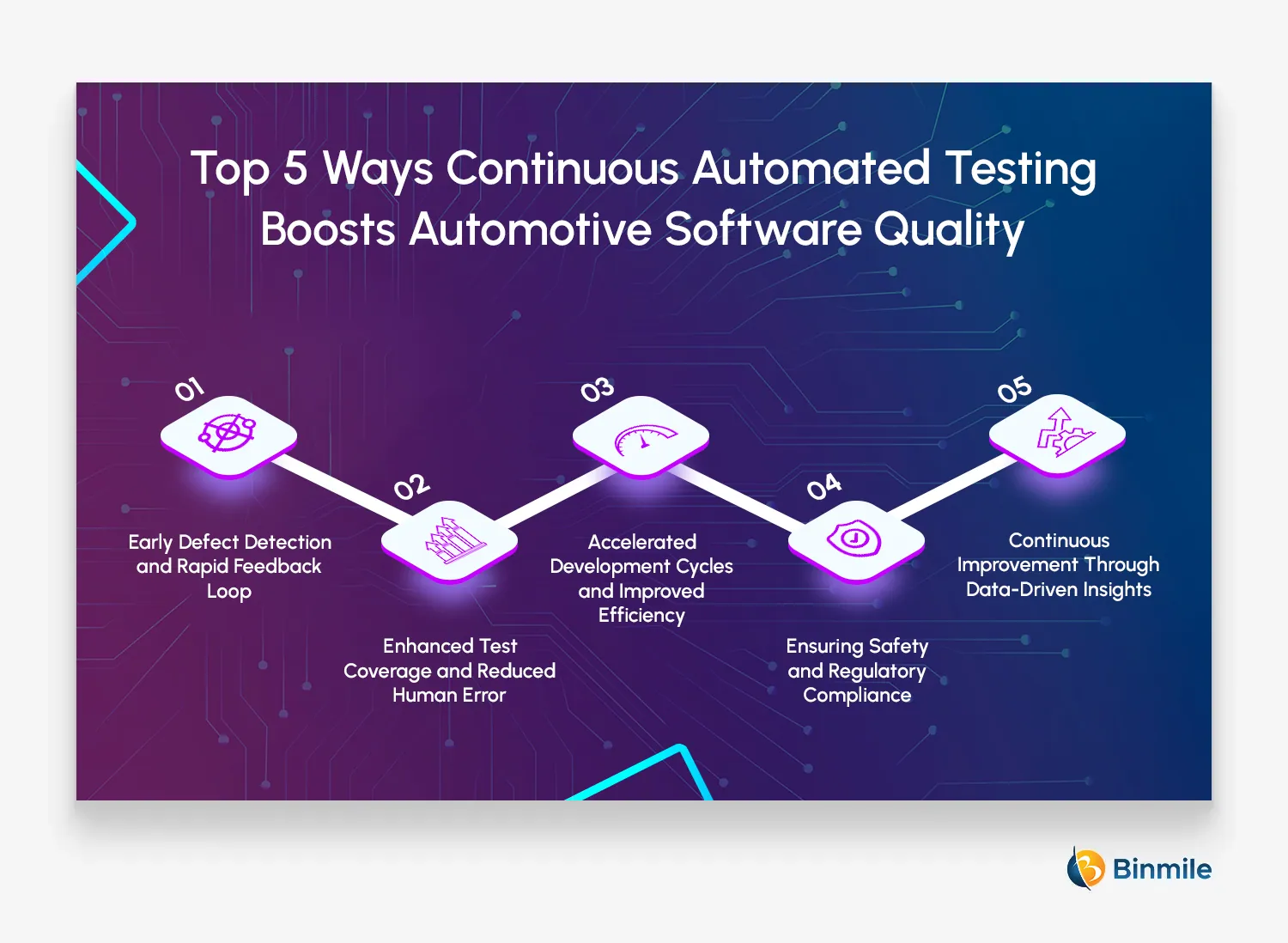Tech-led innovations in the automotive industry are redefining our perception of mobility. Especially when we discuss AI in the automotive industry. Artificial intelligence technology and its subset of machine learning, computer vision, and robotics bring significant innovations to help manufacturers build technologically advanced vehicles. However, the battle to ensure that whatever automobile product automakers build is high-performing and secure and puts them on top of the curve goes behind developing the parts. The real battle is being fought and won in the background, over a line of code through optimal automotive software quality. With modern vehicles running on tens of millions of lines of code, it adds pressure on companies to write, deploy, and integrate code more quickly, efficiently, and with high quality. While traditional manual testing slows down the software quality process, new automated testing for automotive software testing has come to the rescue.
Automated testing not only ensures reliable, secured, and high-functioning automotive software but it also resolves other major concerns for the OEMs or automakers. For instance, rapid advances in technologies such as electrification, AI, connected vehicles, and consumer demand for safer, more personalized driving experiences have led them to consider incorporating new features closer to the start of production and even after vehicles have been sold. It’s only possible if developers get short feedback loops, enabled by continuous automated testing and continually update code without lengthy approval processes. There are other benefits to implementing automated testing for boosting automotive software quality. What are those? How can you successfully integrate continuous automated testing in automotive software? This blog will help you understand why continuous automated testing is critical to automotive software development and more.
Top 5 Ways Continuous Automated Testing Boosts Automotive Software Quality
Software testing is a crucial element in every software development life cycle, and its critical role in the automotive industry cannot be overstated. Since, ensuring the reliability, safety, and error-free operation of the software is paramount, let’s understand what roles continuous automated testing plays in amplifying automotive software quality:

1. Early Defect Detection and Rapid Feedback Loop
Unlike traditional testing methods that run once development stages are over, automated testing seamlessly integrates with the development ecosystem. They run each time a change occurs in the codes. Potential issues are detected early in the development phase, thus preventing them from becoming bigger issues later in the SDLC. For instance, think of a bug in a critical system like driver assistance, and it’s detected halfway through the development process, not during the physical testing of the car’s model. Since feedback is provided by continuous automated testing on a real-time basis, the software development services can fix this issue as soon as possible which develops a culture of quality in the development team
2. Enhanced Test Coverage and Reduced Human Error
The complexities of modern automotive software make manual testing a time-consuming and ineffective process. Continuous automated testing resolves this issue by automating repetitive tasks and frees up testers to focus on other high-level strategic tests. Moreover, automated tests are a better option than manual ones as they can cover a greater number of possible scenarios in comparison to manual testing. This encompasses situations that are not usually tested for during manual testing because they are either rare or are considered to be standard scenarios within the system and hinder its’ progress to achieve the optimal quality build in the software.
3. Accelerated Development Cycles and Improved Efficiency
By facilitating early detection and automating repetitive work, automation testing also speeds up and simplifies the development process. This means that the manufacturers can now design and bring new aspects or features to the new car models at a quicker pace. With fewer resources required for manual testing, development teams experience improved efficiency, leading to significant cost savings. This kind of agility can enable automotive companies to respond fast to the demands of the market and be stable financially in the very competitive automotive market.
4. Ensuring Safety and Regulatory Compliance
Safety and regulatory compliance are important aspects of any organization, and they play a vital role in the automotive industry as well. Thus, it becomes essential that the automotive software is built following stringent safety standards and regulations for ensuring vehicle and passenger safety. This is where continuous automated testing comes in. Implementing the test cases that have been designed particularly for the simulation of safety-critical features, plays a vital role in upholding these standards. Furthermore, documented test cases and the correlation between the requirements and test cases serve valid objectives during the audit. This develops reliable, secure, and compliant software throughout the development cycle.
5. Continuous Improvement Through Data-Driven Insights
Executing automated tests generates a significant amount of useful data on a software’s performance as well as its potential issues. By utilizing this data, developers can maintain a proactive approach to find errors, gaps, or missing requirements in comparison to the actual requirements. For example, automated tests can detect a specific software component that’s more error-prone. Thus, by knowing exactly which component is creating repeated problems, developers can focus on strengthening that component and, therefore, improve the quality of software products. This data-driven outlook constantly improves automotive software, making it capable of adjusting to emerging top software development trends and delivering higher quality and performance.
Know the Difference: Manual vs Automation Testing
Best Practices for Implementing Continuous Automated Testing in Automotive Projects
Here’s a quick guide on how to initiate continuous automated testing in your automotive projects:
- Focus on areas with high safety impact or frequent regressions.
- Adopting a multi-layered approach to run tests ensures all areas within the development lifecycle are covered.
- Choose CI/CD integration into the deployment pipeline, so that the checks would always run before a new build is produced.
- Utilize quantifiable metrics to keep track of your success or failure rate during testing.
Types of Continuous Automated Testing
We recommend you leverage a different combination of continuous automated testing types, rather than focusing on a few. Doing so will help you improve the quality of your software and ensure that it is safe, reliable, and meets all of its requirements. These are:
| Unit Testing | Integration Testing | Functional Testing | Regression Testing |
|---|---|---|---|
| Verifies individual code modules function as intended or prescribed by the SDLC team. | Check different code modules are working together seamlessly without disruptions or not. | Ensures the software meets its designed functionalities through simulated user interactions. | Automates tests to guarantee new code changes don’t disrupt existing features. |
| API Testing | Performance Testing | In-Vehicle Testing | Security Testing |
| Maintains API functions as expected to ensure smooth communication between software components. | Evaluates software performance under different load conditions for responsiveness and stability. | Assesses real-world functionality of the software by testing vehicle components and systems in their final environment. | Identifies the functionality and security of embedded systems, and mitigates vulnerabilities in the software stack. |
Wrapping It Up
The automotive industry needs to be constantly innovative in terms of performance, durability, and quality for them to be highly competitive. To ensure they deliver automotive software that improves the safety and comfort of drivers and passengers, the software needs to be checked to ensure that it functions correctly and mitigates any errors or bugs timely. However, with so many complex systems and codes, manual testing slows down the testing and therefore development process. Automated testing for business resolves all these issues and increases the depth and scope of tests to help improve automotive software quality.
In this blog, we discussed the importance of integrating continuous automated testing for automotive software. We also explored how automated testing does more than improve the quality of automotive software. It also enhances testing efficiency, accuracy, and speed by automating repetitive and time-consuming manual testing tasks. If you are also looking forward to understanding how you can leverage this transformative nature of automated testing, consult an automation testing company. Their testers can offer on-target software testing for critical embedded systems, to help you deliver high-quality automotive products or systems.









